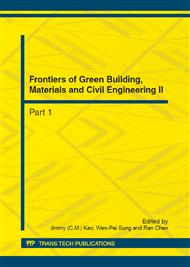[1]
Y. Zhang and C. Bull: Landscape architecture as international practice: Trends in Australia and China as a Client, in: Urban Planning International Vol. 23(5), (2008), pp.69-75
Google Scholar
[2]
G. Paterson and A. T. Pettus: The visible landscape, in: The culture of landscape architecture, edited by H. Edquist and V. Bird, Melbourne, Vic., Edge Publishing in association with the Dept. of Planning Policy and Landscape RMIT (1994) pp.139-154
Google Scholar
[3]
J. Corner, Eds: Recovering landscape: essays in contemporary landscape architecture, New York, Princeton Architectural Press (1999)
DOI: 10.1017/s1359135500002293
Google Scholar
[4]
C. Girot: Four Trace Concepts in Landscape Architecture, in: Recovering landscape: essays in contemporary landscape architecture, edited by J. Corner, New York, Princeton Architectural Press (1999) pp.59-67.
DOI: 10.1017/s1359135500002293
Google Scholar
[5]
A. R. Arvidson, and F. E. Martin: Changing places: where history and nature collide, in: Landscape Architecture Vol. 97(11), (2007) pp.48-57.
Google Scholar
[6]
R. Lorch, and R. Cole, Eds: Buildings, culture and environment: informing local and global practices, Oxford, UK; Malden, MA, Blackwell Pub (2003).
DOI: 10.1002/9780470759066
Google Scholar
[7]
R. Cole and R. Lorch: Introduction: knowledge, values and building design, in: Buildings, culture and environment: informing local and global practices, edited by R. Lorch and R. Cole. Oxford, UK; Malden, MA, Blackwell Pub (2003) pp.1-8.
DOI: 10.1002/9780470759066
Google Scholar
[8]
C. Bull and D. Boontharm: Reflecting on cross-cultural interactions, in: Cross-cultural urban design: global or local practice, edited by C. Bull, D. Boontharm and C. Parin, London, Routledge: (2007) pp.129-134.
DOI: 10.4324/9780203826225
Google Scholar
[9]
Z. Sun, and G. Shao, Eds: Wuxi stepping toward an ecological water-mountain waterfront city: chronicles of the building of the new city of Li Lake Wuxi, Wuxi's Municipal Committee of the Planning and Construction of Lihu City (2007).
Google Scholar
[10]
Y.-f. Tuan: Space and place: the perspective of experience, Minneapolis, University of Minnesota Press (1977)
Google Scholar
[11]
D. W. Meinig: The beholding eyes, in: The Interpretation of ordinary landscapes: geographical essays, edited by, D. W. Meinig (1979) pp.33-48
Google Scholar
[12]
C. Norberg-Schulz: Genius loci: towards a phenomenology of architecture, London, Academy Editions (1980)
Google Scholar
[13]
M. Hough: Out of place: restoring identity to the regional landscape, New Haven, Yale University Press (1990)
Google Scholar
[14]
H. Edquist, and V. Bird, Eds: The culture of landscape architecture, Melbourne, Vic., Edge Publishing in association with the Dept. of Planning Policy and Landscape RMIT (1994).
Google Scholar
[15]
G. Seddon: Landprints: reflections on place and landscape, Cambridge; Melbourne, Cambridge University Press (1997)
Google Scholar
[16]
M. Hebbert and W. Sonne: History builds the town: on the uses of history in twentieth-century city planning, in: Culture, urbanism and planning, edited by J. Monclus and M. Guardia. Aldershot, England; Burlington, VT, Ashgate (2006): pp.3-19.
DOI: 10.1080/01944360802540638
Google Scholar


